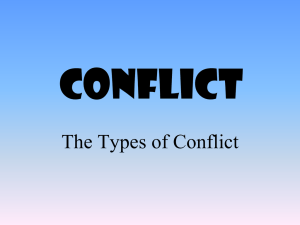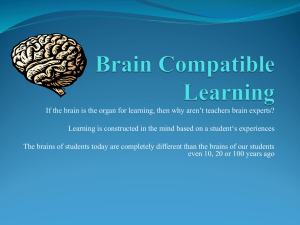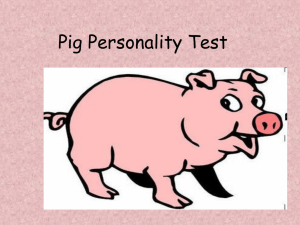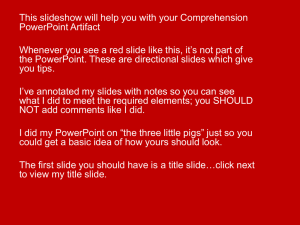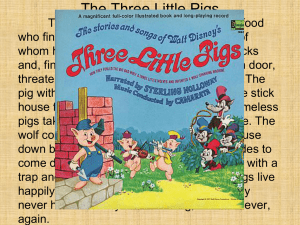PowerPoint for 2nd Grade Pre-Service
advertisement
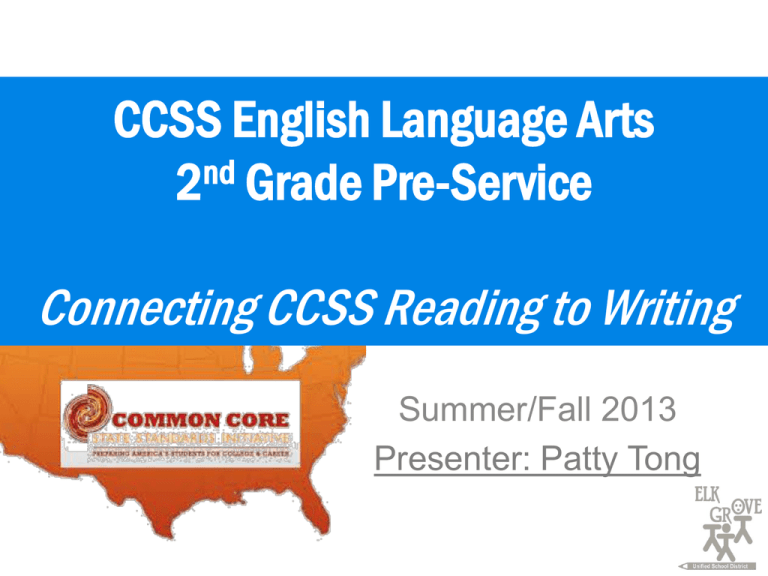
CCSS English Language Arts nd 2 Grade Pre-Service Connecting CCSS Reading to Writing Summer/Fall 2013 Presenter: Patty Tong Welcome & Introductions Good Morning! How much experience do we have in the room? Logistics • Today’s Schedule o 8:00-12:00 training o Planning time in the afternoon at school sites • Restrooms • Workshop Contents – CCSS Website Contents of Summer Training • Speaking/Listening standards – Structured Student Interaction – Implications for diverse learners • Reading – Foundational Skills • Reading – Literature/Informational Text – Text Dependent Questions – Close Reading nd 2 Grade Outcomes Examine Language Standards Understand text types and purposes of the Writing Standards Connect writing to reading Turn reading tasks into writing prompts or assessment questions Use rubrics to help plan writing instruction Language Standards Standards-at-a-Glance Handout Examine Language Standards Directions: 1. Read Conventions of Standard English standards 1-3. 2. Read Vocabulary Acquisition and Use standards 4-6. 3. Discuss the implications for teaching #4-6 during both reading and writing instruction. Big Ideas Language = Conventions + Vocabulary Acquisition and Use Vocabulary is heavily emphasized and should be woven into both reading and writing instruction. Organization of the Writing Standards Writing Strand “Cluster” Text Types and Purposes Production and Distribution of Writing Research to Build and Present Knowledge Range of Writing Standard # 1-3 4-6 7-8 10 Examining Writing Standards Pages 4-5: Writing Trace: Text Types and Purposes - #1-3 Let’s walk through #1 together. Debrief Writing Trace What commonalities BETWEEN writing standards #1-3 did you notice (e.g., “sense of closure” at first grade for all three standards)? What are the implications for classroom instruction? Writing Standards 4-10 • Read the remaining writing standards in the “clusters” of 4-6, 7-9, and 10. Big Ideas Writing has 3 text types and purposes: 1) opinion, 2) informational/explanatory, and 3) narrative. Explicit writing skills overlap within standards 1-3. Writing instruction requires a K-12 “team” approach due to its interdependence. Connecting Writing to Reading CCSS – Measuring Grade-Level Appropriate Text 3 Factors: 1. Qualitative (content/sophistication) 2. Quantitative (lexile/readability measures) 3. Reader and Task (purpose and complexity of assignment) p. 9 - CCSS Reading Tasks: Connecting Reading to Writing Examine Reading Tasks THINK-PAIR-SHARE Which of these tasks for your grade-level TWO-FER! would could be/best be assessed through a writing task? Big Ideas Use reading standards in connection with a writing standard. Appendix B provides an opportunity to look at examples of reading tasks that would best be assessed through a writing task. Assess both reading and writing—a “two-fer.” It is like watching a DVD. Focus Standards RL 2- Recount stories, including fables and folktales from diverse cultures, and determine their central message, lesson, or moral W1- Write opinion pieces in which they introduce the topic or book they are writing about, state an opinion, supply reasons that support the opinion, use linking words (e.g., because, and, also) to connect opinion and provide reasons, and provide a concluding statement or section. Task Analysis • Summarize the story • Idea of learning lessons (central message) • Finding evidence – Use of a graphic organizer to cite evidence – What is evidence supports the central message? – Relevant reasons • Topic Sentence • Concluding statement or section • Linking words Concrete to Abstract Mini Lesson: Central Message Mini Lesson : Central Message CHECKLIST: It is written as a complete sentence. It is a message or lesson from the author. It does not mention specific characters or events from the story. It has text evidence to support the central message(s). Example: “The Three Little Pigs” Mini Lesson: Citing Evidence Central Message: When faced with a dangerous situation, it is best to stay calm and think things through. Select: A and G This evidence (does/does not) support the central message because_____. Mini Lesson: Citing Evidence Central Message: When faced with a dangerous situation, it is best to stay calm and think things through. Evidence (Examples) G. Pig goes early, makes dinner before the wolf gets there Reasons Pig thinks ahead and gets back safely before the wolf arrives This evidence (does/does not) support the central message because_____. Mini Lesson: Citing Evidence Central Message: When faced with a dangerous situation, it is best to stay calm and think things through. Select: C and D This evidence (does/does not) support the central message because_____. Mini Lesson: Citing Evidence Central Message: When faced with a dangerous situation, it is best to stay calm and think things through. Evidence (Examples) G. Pig goes early, makes dinner before the wolf gets there C. Hung pot of water, wolf fell in, pig ate him for dinner Reasons Pig thinks ahead and gets back safely before the wolf arrives When the pig saw what he was doing, he made a plan to protect himself and get dinner This evidence (does/does not) support the central message because_____. RL: Standard #2 Graphic Organizer Options to Scaffold Graphic Organizer Provide to students Provide to students Provide to students Provide to students Graphic Organizer : Central Message and Evidence Partner Talk For the group of students you will be working with, at what level of scaffolding (which mini lesson) will you need to start for central message and why? “The Library” Sort Short Answer What is a central message of “The Three Little Pigs”? Use evidence from the text to support your answer and supply reasons that support your opinion. Mini Lesson: Topic Sentence Each sentence in a paragraph has a “job” to do. The “job” of the topic sentence is to tell what the paragraph is going to be about. Mini Lesson: Topic Sentence Language Frame: The central message of “The Three Little Pigs” is ___________________. Mini Lesson: Citing Evidence Central Message: When faced with a dangerous situation, it is best to stay calm and think things through. Evidence (Examples) G. Pig goes early, makes dinner before the wolf gets there C. Hung pot of water, wolf fell in, pig ate him for dinner Reasons Pig thinks ahead and gets back safely before the wolf arrives When the pig saw what he was doing, he had his own plan This evidence (does/does not) support the central message because_____. Example Topic Sentence The central message of “The Three Little Pigs” is when faced with a dangerous situation, it is best to stay calm and think things through. Mini Lesson: Citing Evidence Central Message: When faced with a dangerous situation, it is best to stay calm and think things through. Evidence (Examples) G. Pig goes early, makes dinner before the wolf gets there C. Hung pot of water, wolf fell in, pig ate him for dinner Reasons Pig thinks ahead and gets back safely before the wolf arrives When the pig saw what he was doing, he had his own plan This evidence (does/does not) support the central message because_____. Transition Words Grade Level Linking Words: because, and, also Examples of other phrases: One example from the story… Another… Finally… In addition… Example with Evidence The central message of “The Three Little Pigs” is when faced with a dangerous situation, it is best to stay calm and think things through. One example from the story is when the pig leaves to pick up the turnips early. Mini Lesson: Citing Evidence Central Message: When faced with a dangerous situation, it is best to stay calm and think things through. Evidence (Examples) G. Pig goes early, makes dinner before the wolf gets there C. Hung pot of water, wolf fell in, pig ate him for dinner Reasons Pig thinks ahead and gets back safely before the wolf arrives When the pig saw what he was doing, he had his own plan This evidence (does/does not) support the central message because_____. Language Frames for Reasons Ask yourself: “HOW does the evidence help support what you said the central message was?” • This supports the central message because_________. • This shows_______ because________. • This evidence proves how/why (restate central message) because_______. Example with Reason The central message of “The Three Little Pigs” is when faced with a dangerous situation, it is best to stay calm and think things through. One example from the story This supports the central message because the pig was thinking ahead and was able to get home safely before the wolf arrives. is when the pig leaves to pick up the turnips early. Mini Lesson: Concluding Statement Each sentence in a paragraph has a “job” to do. The “job” of the concluding statement is to sum up/ restate the topic sentence with different words. Example with Conclusion The central message of “The Three Little Pigs” is when faced with a dangerous situation, it is best to stay calm and think things through . One example from the story is when the pig leaves to pick up the turnips early. This supports the central message because the pig was thinking ahead and was able to get home safely before the wolf arrives. Taking time to think and problem solve is always helpful when facing a dangerous situation. Table Talk Getting students to write a paragraph from topic sentence to concluding sentence is a huge accomplishment. What steps would you as a grade level team need to take in order to achieve this goal? Lesson Preparation Determine possible central messages and list evidence (cite page number) to support the central message for the following selections: “Ant and the Three Little Figs” “Come Back, Jack!” “Story Hour, Starring Megan” Central Message CHECKLIST: It is written as a complete sentence. It is a message or lesson from the author. It does not mention specific characters or events from the story. It has text evidence to support the central message(s). Students will need to have frequent, formative feedback coupled with opportunities to revise and resubmit tasks. Supporting Student Growth Frequent Formative Feedback Loop Students produce tasks Teachers provide specific, targeted feedback Student use feedback to improve The Power of Formative Feedback: Austin’s Butterfly Debrief Video • What are significant ideas presented in this video? • What implications for instruction exist? Big Ideas Formative assessment and feedback is critical for students to make progress as writers and students with transferable skills. Feedback should be targeted and narrow in scope. Writing tasks do not have a definitive number of drafts. Using Rubrics as Instructional Tools • One way to provide formative feedback is to use common rubrics. • This can be done with teaching very explicit skills. • These rubrics can even be used as planning tools for the teacher. Debrief – Walk & Talk Please choose a language frame: • Two things that I learned about analytic or holistic rubrics are_______ and _______. • One thing that I learned about analytic or holistic rubrics is _________, but I still have a question about ________. Evaluation nd th eCPL – 2 -6 Grade Formative Assessments And now a word from EGUSD about upcoming formative assessments… Did you sign in?

